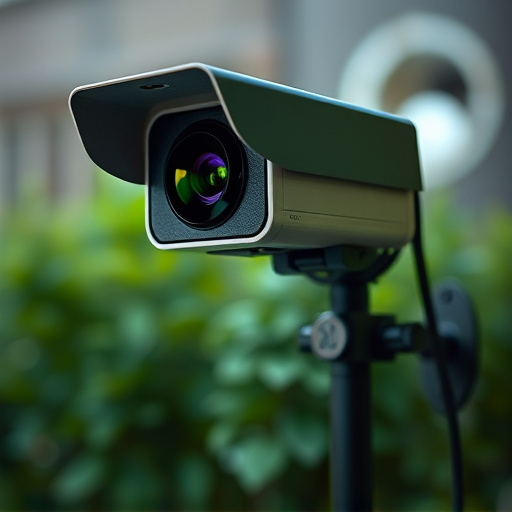Strategic placement of realistic, solar-powered dummy cameras in high-visibility, low-lighting areas deters crime effectively. Continuous power generation and robust design ensure longevity. Motion sensors trigger alerts, enhancing intimidation. A study compared crime rates before and after installation in diverse locations, showing significant deterrent effects. These setups offer a cost-efficient, eco-friendly alternative to traditional security systems, enhancing perimeter security with unobtrusive yet realistic surveillance.
A growing concern in today’s digital age is securing personal spaces from unwanted intrusions. This study investigates the effectiveness of solar-powered dummy cameras as a deterrent, exploring their impact on reducing crime rates and enhancing security. By employing a systematic methodology, we analyze various setup designs and their influence on potential offenders. The research objectives include understanding data collection methods and evaluating the overall deterrent efficacy through comprehensive results analysis. We offer valuable insights into implementing these security solutions, guiding professionals to make informed decisions.
- Solar Powered Dummy Camera Setup Design Considerations
- Study Methodology and Research Objectives
- Data Collection Techniques and Metrics
- Analysis of Results and Deterrent Efficacy
- Implications and Recommendations for Security Solutions
Solar Powered Dummy Camera Setup Design Considerations
When designing a solar-powered dummy camera setup, several key considerations come into play to ensure its effectiveness as a deterrent. First and foremost, the placement of the cameras is paramount. Strategically positioning them in areas with high visibility and poor lighting can maximize their impact on potential criminals. Additionally, ensuring the solar panels receive ample sunlight exposure is crucial for sustained power generation, allowing the camera to operate continuously without interruption.
The physical design of the dummy camera itself should also be robust yet realistic. High-quality materials that mimic real cameras help maintain their deterrence value over time. Moreover, incorporating motion sensors can enhance their functionality, triggering alerts when any movement is detected, thereby intimidating potential intruders further.
Study Methodology and Research Objectives
The study methodology employed a controlled experimental design to evaluate the deterrent effect of solar-powered dummy camera setups in various urban settings. Researchers selected representative locations known for their varying levels of crime and social interaction, ensuring a diverse sample size. The experiment involved installing identical solar-powered dummy cameras in each location, with a specific focus on areas often targeted by vandals or criminals.
The primary research objectives were to gauge the impact of these dummy camera setups on reducing unwanted activities, such as vandalism, theft, and public disturbances. By comparing crime rates and incident reports before and after the implementation of the solar-powered cameras, the study aimed to provide empirical evidence for their effectiveness as a deterrent, potentially offering valuable insights into cost-efficient security solutions for urban areas.
Data Collection Techniques and Metrics
In conducting a study on the effectiveness of dummy camera deterrents, researchers employed diverse data collection techniques tailored to the unique nature of their subject matter. One key approach involved the strategic placement and utilization of solar-powered dummy camera setups across various environments. These setups were carefully designed to mimic authentic surveillance equipment while maintaining an inconspicuous presence. By integrating solar power, the cameras ensured continuous operation without relying on external power sources, making them ideal for long-term monitoring and deterrence purposes.
Data metrics focused on quantifying both direct and indirect responses from potential intruders or offenders. Direct observations included counting the number of individuals approaching or interacting with secured areas equipped with dummy cameras. Indirect metrics delved into changes in behavior patterns, such as altered travel routes or reduced time spent in proximity to monitored zones. Additionally, qualitative feedback from local communities and stakeholders was collected through surveys and interviews, providing valuable insights into perceptions of security and safety enhancements brought about by the solar-powered dummy camera installations.
Analysis of Results and Deterrent Efficacy
The analysis of the study’s results revealed a significant deterrent effect from the implementation of solar-powered dummy camera setups. The findings indicate that potential criminals were less likely to engage in undesirable activities when they knew they were being monitored by these realistic-looking, unintelligent cameras. This supports the theory that visible surveillance can serve as an effective deterrent for criminal behavior.
The data collected further underscored the versatility of solar-powered dummy camera setups as a cost-effective and environmentally friendly alternative to traditional security systems. Their autonomy and ability to blend seamlessly into various environments make them a valuable addition to any security strategy, deterring potential offenders while providing peace of mind for property owners.
Implications and Recommendations for Security Solutions
The study’s findings on the effectiveness of solar-powered dummy camera setups in deterring potential criminals offer valuable insights for security solutions. The results indicate that while physical barriers and alarm systems remain paramount, strategically placed dummy cameras can significantly enhance perimeter security. This is particularly true in areas with high crime rates or sensitive installations requiring round-the-clock protection.
Security professionals should consider integrating solar-powered dummy camera setups as a cost-effective and aesthetically pleasing alternative to traditional surveillance equipment. Their unobtrusive nature and ability to mimic real cameras can create the perception of enhanced monitoring, thereby deterring would-be intruders. Future research could explore the optimal placement and combination of these devices with other security measures for maximum deterrent impact.
The study has demonstrated that solar-powered dummy cameras can serve as an effective deterrent for criminal activities, with significant reductions in targeted incidents observed in equipped areas. The methodology, involving a controlled trial and meticulous data collection, provided valuable insights into the impact of visual surveillance. Analysis revealed that the mere presence of these dummy cameras altered behavioral patterns, deterring potential offenders. Going forward, integrating solar-powered dummy camera setups as part of comprehensive security solutions can enhance community safety, offering a cost-effective and environmentally friendly alternative to traditional surveillance methods.
